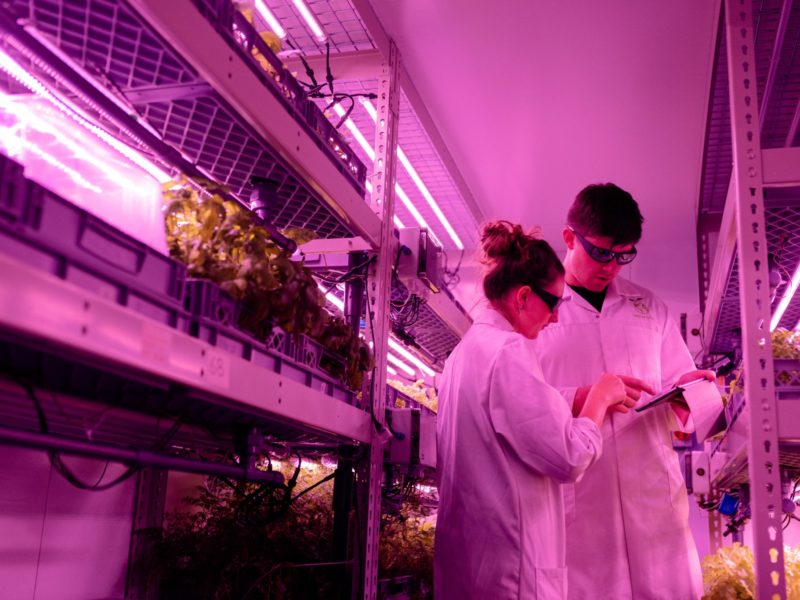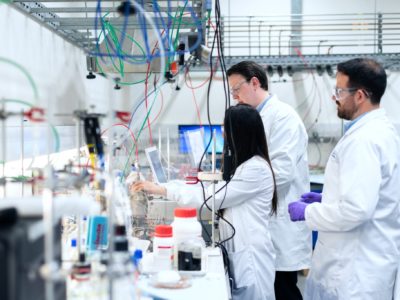The very nature of STEM is that it’s always evolving as researchers and inventors build on past knowledge to spark innovation. Mobile app developers, big data analysts and driverless car engineers are all up-and-coming roles in fields that only exist because of the endless forward march of human progress.
Keep an eye out for these 10 emerging STEM fields.
1. Artificial Intelligence

When we think of emerging STEM fields, most of us will think of artificial intelligence–for a good reason. “Artificial intelligence is the ability to build machines that are intelligent, i.e. that can perceive the world or infer information, transform the information into knowledge and use the knowledge or context to operate in its environment,” said Dr. Henrik Christensen, Director of the Institute of Contextual Robotics. Turns out, artificial intelligence isn’t just about robots and driverless cars. Artificial intelligence is used in disease diagnosis, stock market predictions, music recommendations on Spotify, workout recommendations on apps, navigation and more. “The number of places where we use A.I. is almost infinite…there are very few places where A.I. will not play a role in our future,” Christensen said. “This is the core technology that enables all the applications.” In the future, A.I. will likely be essential in manufacturing, healthcare and transportation. Artificial intelligence will no longer be the muse of dystopian science fiction.
2. Bioinformatics

Bioinformatics is not for the faint-hearted. “Bioinformaticians can be ‘tool-builders’ that design and implement algorithms to query biological data or ‘data scientists’ who use these tools to make biological discoveries,” said Dr. Vineet Bafna, Director of Bioinformatics Program at the University of California, San Diego. Today’s bioinformaticians are in for a real treat. With seemingly endless torrents of biological data generated, bioinformaticians are in high demand to build algorithms to make sense of large data sets. Bioinformatics drives biomedical research and drug discovery, causing pharmaceutical, biotechnology and software companies to seek professionals with bioinformatics experience. “Without bioinformatics, genome science and many other fields of biological inquiry could not exist,” said Dr. Justin Meyer, assistant professor and researcher at UC San Diego. “Bioinformatics will become more and more prevalent and for biomedical research, it will become just like a basic science course similar to chemistry or biology,” said Dr. Ferhat Ay, Institute Leadership Assistant Professor of Computational Biology at the La Jolla Institute for Immunology. For bioinformatics, the sky’s the limit.
3. Proteomics

Proteomics is the study of proteomes. Although not all of us know what a “proteome” is, I bet we are all familiar with its cousin, protein. If our genes represent what all the cells in our bodies can do, then proteomes (complete sets of proteins) represent everything the cells are actually doing. Proteomics is a field dedicated to understanding how proteins function and interact to perform functions within and between cells, tissues and organisms. “Not only are proteins the actual ‘engine of life,’ proteins are also of critical importance in how we respond to disease in two major ways: our own immune system responds to infection by making antibody proteins and the vast majority of drug targets are the proteins involved in the underlying biological processes,” said Dr. Nuno Bandeira, Executive Director at Center for Computational Mass Spectrometry. Analyzing proteomes relies on data shared among a global community of scientists, engineers and even lawmakers who decide how information should transform society, especially in data science and medical treatment for diseases like cancer.
4. Synthetic Biology

While the term “synthetic biology” may be relatively new, the idea of humans having the ability to redesign and reengineer life has been around since at least Frankenstein. Using bioinformatic and simulation tools, synthetic biologists build circuits that will introduce or modify biological functions. And just as engineers now design circuits based on physical properties of materials, synthetic biologists will soon design and build engineered biological systems. Pharmaceutical, energy, medical and agricultural companies are using synthetic biology to create many things that would not be possible otherwise in applications as diverse as plant fertilizers, vaccines, and even fashion. There are many mysteries still existing in the field of biology, and it’s up to synthetic biologists to discover (some of) them.
5. Big Data and Data Science

We are all too familiar with how social media can connect millions of people every day and how quickly information is shared and generated. But how is huge and diverse data like this managed, processed and stored? This is where Big Data comes to play. Big data analytics is the use of advanced analytic techniques against very large and diverse data sets. These data sets are so large in volume, velocity and variety that traditional data processing algorithms can’t manage them. Big data helps people spot business trends, prevent diseases, combat crime and much more. Now, big data is a big game-changer in most, if not all, types of modern industries over the last few years. Big data has revolutionized information technology and is driven by scientific research and by organizations gathering huge amounts of operational and behavioral information to create new services. In fact, big data affects all of us personally. From GPS to Spotify and Netflix streaming…big data is everywhere.
6. Environmental Science and Policy

Environmental science is an evergreen field of study and research drawing on many disciplines. Analyzing the interaction between humans and the Earth, scientists research environmental issues and work with policymakers to address environmental problems and to implement science-based solutions. “Good environmental policy requires a deep understanding of the underlying environmental science as well as the social sciences that shape policymaking decisions,” said Dr. Joshua Zivin, the Pacific Economic Cooperation Chair in International Economic Relations at the University of California, San Diego. “We cannot alter the course of our planet without understanding the physical laws that govern cause and effect. At the same time, we cannot alter those ‘causes’ without the socioeconomic tools required to influence individual and collective decision making. It is precisely this intersection that is the focus of interdisciplinary environmental studies programs.” Without a “Planet B” for us to inhabit yet, environmental science is only going to become more important in the future.
7. Cognitive Economics

What are people willing to give up to get a product or service? How much is it worth? How can society satisfy everyone’s psychological and material desires? Cognitive economics can help answer these questions by looking into mental states, beliefs and emotions. Cognitive economists see thoughts as inputs and outputs, costs and trade-offs–ideas that are fundamental to economics. Starting at a lower level, from a small-scale model of how people make decisions, cognitive economists work upwards theoretically, to develop a model of large-scale economic behavior. Turns out, economics isn’t just about markets and numbers. A lot of thinking and psychology factors into it as well.
8. Neuroethics

With advances in neuroscience and technology, crazy, even scary, gadgets featured in the dystopian show Black Mirror may materialize sooner than we imagine. Many people are concerned about the ethical implications of expanding our neurological and technological know-how. Moral dilemmas like these are termed “neuroethics.” This field of study anticipates and addresses ethical questions in neuroscience research. More than that, this field addresses questions like should brain images be used to assess the guilt of criminal defendants? Should students or workers use wakefulness-promoting drugs to function literally 24/7? Is it fine to manipulate the neural systems to enhance criminal interrogation? What about brain privacy and the potential misuse of neuroimaging information? With the help of neuroethics, hopefully, we will be able to draw the line between productive and unethical technology.
9. Global Health

From outbreaks of infectious diseases to non-communicable diseases like cancer, to the health impacts of environmental pollution and climate change and humanitarian crises, global health is becoming increasingly important. Global health examines transnational health issues and solutions and synthesizes population-based prevention with individual-level clinical care. “Studying [global health] is an opportunity to further understand the individual and social experiences of health and illness, analyzing these processes in terms of power structures and community dynamics,” said Dr. Paula Saravia, a medical anthropologist at the University of California, San Diego. Not only does global health spur creativity and passion, but it also raises political awareness and community engagement and conflates perspectives from people of different cultures and credentials when building health solutions. “I cannot imagine working in a different field,” said Dr. Saravia, recounting her experience working with people of various expertise. There’s a place for you in global health if you prefer hard sciences, social sciences like sociology and political science or social justice advocacy to empower communities globally.
10. Computational Neuroscience

Fun fact: there are more nerve cells in our brains (100 billion) than stars in our galaxy. This is why research into how our brains work is never-ending. Computational neuroscience helps us understand how we are able to think and process information in our brains. Using tools and theories, computational neuroscience incorporates approaches from electrical engineering, computer science, and physics to help us understand how we are able to think and process information in our brains. One of the most rapidly growing subfields in neuroscience, computational neuroscience has also become important globally, not just in neuroscience but in industry, where artificial intelligence research is on the rise. Even though scientific and computational research advances by the day, it still pales in comparison to the complexity of our minds. That’s why building models is so important- it helps scientists better understand complex problems.

















